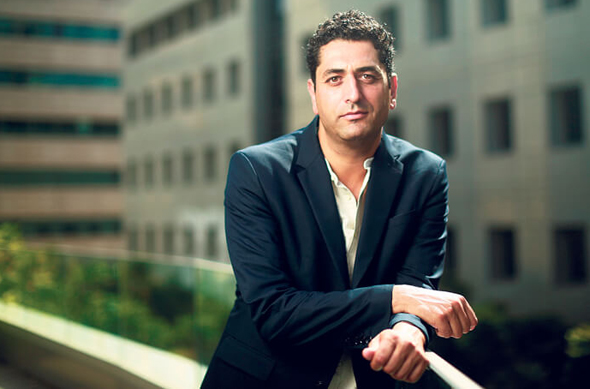Interview
Investments are flowing into synthetic biology - the red-hot field that will change the world
Synthetic biology seemed like science fiction until the arrival of the coronavirus vaccines. But now the money has begun to flow and companies are revealing remarkable inventions: from bacteria that will attack tumors to shoes made of cobwebs
Grossly-generalizing, synthetic biology is an advanced version of genetic engineering, where scientists can cross species and create hybrids, whether they be fruits, vegetables, or in certain cases animals, “implanting” desirable traits. Synthetic biology genetically engineers live cells by implanting them with a specific genetic code in order to create an entirely new living strain that carries those traits.
 Dr. Johann Elbaz. Photo: Amit Shaal
Dr. Johann Elbaz. Photo: Amit Shaal “It’s like the puzzle of life, and we’ve cracked it,” Dr. Johann Elbaz told Calcalist in an interview. Elbaz is one of the leading researchers in the field, and brought synthetic biology to Israel straight from MIT, where he completed his postdoctoral studies in 2016. “Over a decade ago some scientists said ‘let’s play with DNA.’ Now, we’ve gotten down to the knitty-gritty of nature. Everyone knows that the forces of nature are the strongest in existence, and create life. Today, we have the knowledge and ability to not only understand their importance, but to play with those forces.”
Funds start to flow
How do you play with the forces of nature? Elbaz is working on creating a facility that will genetically engineer bacteria in Israel, and compared the process of synthetic biology by supplying a kitchen analogy. “Instead of trying a different recipe each time, synthetic biology allows us to speed up thousands of recipes simultaneously, while making minor tweaks: by either adding another teaspoon or less of sugar, salt, flour, or eggs; taking another minute or less in the preparation, raising or lowering the temperature by a degree or two - until you find the perfect recipe,” he said simply.
The real undisputed star of this field is Ginkgo Bioworks, which was founded in 2009 by four synthetic biologists from MIT, whose mentor Tom Knight was a computer genius and began his university studies at the age of 14. In 2018, Gingko succeeded in recreating a scent of a Hibiscus flower that had grown in Hawaii but went extinct 108 years ago. The company’s scientists took samples from surviving dried flower samples from Harvard, and recreated parts of the flower through its DNA, restoring its scent.
This achievement, in addition to those by similar companies, has proved that the technology is applicable and opened the gates for more innovation. Gingko has already raised nearly $800 million, its yearly revenues have reached $150 million, and one of its prominent investors is Bill Gates. Soon, it hopes to enter the New York Stock Exchange at an amazing $15 billion valuation. Its initial public offering (IPO) will be a springboard that will jumpstart the next era of synthetic biology. It isn’t a coincidence that Gingko wants its stock symbol to be “DNA,” and be synonymous with the field.
Then, the coronavirus (Covid-19) pandemic broke out. Pfizer and Moderna’s vaccines were developed thanks to synthetic biology, which transported them from laboratories to the commercialized industry. The year 2021 appears to be the field’s big break. Many researchers compare 2021 to the point that artificial intelligence was at, five years ago, where many thought it was a futuristic concept, and few understood how it would later revolutionize technology. Since then, it has become a core component in the technology of an infinite number of companies and countless fields.
The year 2020 also marked a big breakthrough for synthetic biology companies’ fundraising, with round totals leaping from $3 billion to nearly $8 billion. This year the pace increased, and synthetic biology companies raised $4.6 billion in only the first quarter of 2021. Last week another synthetic biology company broke a new record, when Pivot Bio announced it raised $430 million. The company has become the first commercialized producer of a genetically-engineering microbe fertilizer that absorbs nitrogen at an accelerated rate to improve corn and rice yields, and has replaced expensive, artificial, and non-environmentally friendly products. Zymergen is another rising star, going public last April, and is now traded at a $4 billion valuation.
- Betalin Therapeutics receives EU equity investment for its alternative insulin therapy
- ‘Spiderman’ technology spins new artificial skin for patients
- PlayBeyondBio names nine healthtech startups for mentoring and development program
RNA robots
Elbaz (40) began his academic career in chemistry, and continued to complete his master’s and PhD in nanotechnology at the Hebrew University of Jerusalem. Later, he realized that his dream wasn’t in chemical research, and in 2011 he left and went to MIT to complete his post doctorate in synthetic biology - a field that was still in its infancy at the time. In addition, his studies would not be funded, and he was notified that he’d have to be self-reliant. “During the course of my PhD, I happened to meet the CEO of Integrated DNA Technologies, a biotech company that sold DNA to labs,” he says. “I told him about my plans, which hadn’t gotten any traction, and he gave me a $30,000 grant for my postdoc.”
In 2016, Elbaz returned to Israel and started the country’s first synthetic biology lab at the Department of Molecular Microbiology and Biotechnology at Tel-Aviv University. Over time, he became a professor and his students even participated in the annual synthetic biology iGEM competition organized by MIT. During last year’s competition in November 2020, the TAU team won a gold medal, and beat out the MIT team as well as those of Stanford and Harvard. But Elbaz wasn’t there to celebrate the achievement, since at the end of 2019 he decided that if he remained in academia he would miss the real revolution taking place in the commercialized industry. Elbaz quit to head an initiative in the private sector.
But, he didn’t know that the pandemic would change his plans, but would also give him a huge boost since Pfizer and Moderna’s vaccines were a synthetic biology application. Both vaccines are based on an innovative technology that injects messenger RNA molecules into the human body. The molecules contain instructions to replicate the coronavirus’ DNA, and in turn the body responds by creating viral antibodies. “When I was at MIT, engineering RNA was a slow manual process, and was far from becoming commercialized,” Elbaz explains. “The advancement of the robotics industry over the past few years paved the way for RNA mass production, and without it would have been impossible to manufacture the Pfizer and Moderna vaccines.”
The technology behind the vaccines raised industry awareness in Israel too. The Israel Innovation Authority recently published a call for proposals to build synthetic biology infrastructure, and has allocated NIS 40 million ($12.3 million) in grants for entrepreneurs. Elbaz is now working on building a facility that produces genetically-engineered bacteria with the company, Alchemist, of which he is a co-founder. Synthetic biology has several possible applications, many of which are jaw-dropping.
Medicine - Using bacteria present in our bodies to attack tumors
Medicine is probably the area that will benefit most from the biggest breakthroughs that synthetic biology has to offer. A few pharmaceutical companies, led by Roche and Gilead Sciences, have already taken the first steps. Their main idea is similar to that of the mRNA coronavirus vaccines: the human body can be turned into a pharmaceutical production facility, which would make taking a certain dose on a daily basis unnecessary.
Some of these developments may sound like science fiction. For example, those suffering from cancer or who possess a greater genetic risk of suffering from it, could receive a serving of genetically-engineered microbes that will act as “sleeper agents.” The minute that the microbes identify cancer cell markers’, they could activate the immune system to attack them. The use could be more widespread in the future, and those same genetically-engineered microbes could identify infectious diseases like the coronavirus and stimulate an immune response.
Fashion - Creating a jacket from fungal leather and shoes from cobwebs
The fashion industry is also expected to undergo a revolution, and has already adopted certain fabrics that were developed using synthetic biology. One of the most prominent players in the arena is Bolt Threads, which succeeded in creating a leather-like fabric from fungus, termed Mylo. Bolt has signed on with numerous fashion companies who have launched entire collections made of the new “leather.” Designer Stella McCartney launched a corset top and pants; athletic supplier Lululemon offered a yoga mat, and shoemaker Adidas launched their “Stan Smith” classic sneaker that is ecologically-approved. These “pleather” offerings are not produced from live animals, and appeal toward a much larger market of vegan products.
 The new Adidas shoes from BioSteel fibers. Photo: Adidas
The new Adidas shoes from BioSteel fibers. Photo: Adidas Another innovation is using cobwebs, which excel in both their strength and lightness, to create an entirely new fabric - “spider silk.” Using insect-spun webs was not practical in the past, since collecting them is time-consuming. However, when researchers mapped the genomic sequence or cobwebs, they found a way to commercialize it. Instead of waiting until spiders spin their webs, the scientists implanted that sequence into a bacteria, which spins large quantities of the threads rapidly. Adidas has already launched a shoe that is made from those Biosteel fibers.
Due to their strength, those fibers can be used to produce durable clothing. Incorporating those fabrics into military uniforms, for example, could make them knife-resistant too. In the far-off future, army uniforms could be used to repel biological or chemical warfare, by incorporating a bacteria that could identify the presence of chemical or biological weaponry and secrete a neutralizing substance in response. Nowadays, scientists are searching for bacteria that can live inside textiles and preserve its genetically-engineered features, although they have yet to be discovered.
Other developments are also on the horizon, which are thanks to the pandemic, such as fabrics that incorporate antibacterial agents that can repel infections, or bacteria that can secrete ethyl alcohol (found in hand sanitizer), and disinfect fabric.
Military - Do you smell bananas? There might be a terror tunnel up ahead
Synthetic biology has developed many breathtaking possibilities for the defense sector too. Elbaz mentioned that he already has signed contacts with a few different security establishments around the world, who are examining their long-term use. One example would be using bacteria to detect signs of life. Today, bacteria can be engineered and planted in gardens that are composed of proteins that have a high-sensitivity to different colors, temperatures, moisture, and more. Such a bacteria could potentially identify metal underground, such as mines.
One way to receive an indication would be to implant the bacteria with a gene that will transmit a signal that could be detected by a drone. Alternatively, a drone could shine a light on the ground and the bacteria could respond by changing its colors depending on the substance it identified, or release heat and thereby communicate with satellites
 A woman walks on a path highlighted by bacteria emitting phosphorescence in the Netherlands. Photo: Pim Hendricksen
A woman walks on a path highlighted by bacteria emitting phosphorescence in the Netherlands. Photo: Pim Hendricksen Over the past few years, a few labs have made breakthroughs in that regard. In one experiment, researchers - who happened to be Elbaz’s colleagues from MIT - made bacteria “draw” portraits of Albert Einstein and the video game character Super Mario. The bacteria could detect red, green, and blue light, and reflect back a corresponding color.
An additional signal that could be implanted would be transmitting an odor, by “programming” a bacteria to replicate banana or guava enzymes. The gas emitted during their aerobic processes could carry the smell of the fruit, and specially-trained dogs could detect it. Such a bacteria could be used to detect cavities below the surface, such as terror tunnels or pits.
Ethical challenges - How do we prevent that knowledge from falling into the wrong hands?
Synthetic biology also brings with it additional risks and challenges. At the technological level, the biggest challenge is to retain the “programmed” genetic traits for a period of time. Today, those traits only last for a few weeks. Some reasons are evolutionary, and bacteria have traits that allow it to adapt to its environment but changing them could harm its chances of survival. Elbaz explained that a bacteria that lives in Beer Sheva would not be able to adapt to Tel Aviv life. “Like any creature, bacteria don't like changes,” he explains. “In order for that bacteria to get the message that those changes are a matter of life and death, we’d implant an enzyme that will attach to the new genetic code and prevent it from duplicating until it adopts the desired trait. If it wants to survive, it must replicate the copied genetic code, but some bacteria are stubborn and prefer to ‘commit suicide.’”
Greater difficulties pose certain moral issues that arise when human beings try to play God. Human intervention in natural processes, such as releasing into the wild genetically-modified creatures, could have unexpected consequences.
Lastly, another inherent danger lies in the ability of terrorist elements to carry out cyberattacks against genetically-engineered bacteria production plants, steal that knowledge, and use it to create a biological weapon. “I am afraid that the knowledge we’ve accumulated will get into the wrong hands, since it’s very easy to turn synthetic biology applications into biological weapons,” Elbaz admits. “On the other hand, Einstein also didn’t intend for countries to use his knowledge to build a nuclear bomb.” In the meantime, the European parliament has removed most government regulations against synthetic biology, and included it in this years’ list of the top ten most important technologies that helped combat the pandemic alongside artificial intelligence, telemedicine, and 3D printing.



